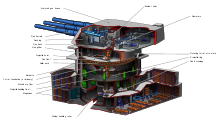
USS Illinois (BB-65) was the fifth Iowa-class fast battleship that was laid down for the United States Navy during World War II in the 1940s, although she would not be completed. The Navy had initially planned on building four of the Iowas and then developing a new, more powerful ship for what was to be BB-65. The pressing need for more warships at the outbreak of World War II in Europe led the Navy to conclude that new designs would have to be placed on hold to allow the shipbuilding industry to standardize on a small number of designs. As a result, BB-65 was ordered to the Iowa design in 1940. Illinois was laid down in December 1942, but work was given a low priority, and was still under construction at the end of World War II. She was canceled in August 1945, but her hull remained as a parts hulk until she was broken up in 1958.
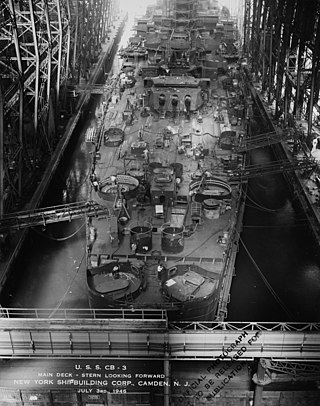
USS Hawaii (CB-3) was intended to be the third member of the Alaska-class large cruisers. It was the first United States Navy ship to be named after the then-Territory of Hawaii. Because Hawaii's construction was delayed by higher-priority ships like aircraft carriers, her keel was not laid until December 1943, about two years after her sister ship Guam.
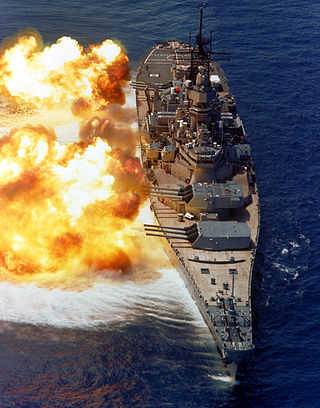
The Iowa class was a class of six fast battleships ordered by the United States Navy in 1939 and 1940. They were initially intended to intercept fast capital ships such as the Japanese Kongō class and also serve as the "fast wing" in a traditional battle line alongside slower battleships. The Iowa class was designed to meet the Second London Naval Treaty's "escalator clause" limit of 45,000-long-ton (45,700 t) standard displacement. Beginning in August 1942, four vessels, Iowa, New Jersey, Missouri, and Wisconsin, were completed; two more, Illinois and Kentucky, were laid down but canceled in 1945 and 1958, respectively, before completion, and both hulls were scrapped in 1958–1959.
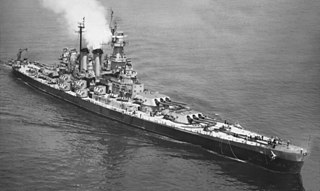
The North Carolina class were a pair of fast battleships, North Carolina and Washington, built for the United States Navy in the late 1930s and early 1940s.

The Alaska class were six very large cruisers ordered before World War II for the United States Navy, of which only two were completed and saw service late in the war. The US Navy designation for the ships of this class was 'large cruiser' (CB) and the majority of leading reference works consider them as such. However, various other works have alternately described these ships as battlecruisers despite the US Navy having never classified them as such. The Alaskas were all named after territories or insular areas of the United States, signifying their intermediate status between larger battleships and smaller heavy and light cruisers.

The Delaware-class battleships of the United States Navy were the second class of American dreadnoughts. With this class, the 16,000 long tons (16,257 t) limit imposed on capital ships by the United States Congress was waived, which allowed designers at the Navy's Bureau of Construction and Repair to correct what they considered flaws in the preceding South Carolina class and produce ships not only more powerful but also more effective and rounded overall. Launched in 1909, these ships became the first in US naval history to exceed 20,000 long tons (20,321 t).

The Yamato-class battleships were two battleships of the Imperial Japanese Navy, Yamato and Musashi, laid down leading up to World War II and completed as designed. A third hull, laid down in 1940, was converted to an aircraft carrier, Shinano, during construction.

The Littorio class, also known as the Vittorio Veneto class, was a class of battleship of the Regia Marina, the Italian navy. The class was composed of four ships—Littorio, Vittorio Veneto, Roma, and Impero—but only the first three ships of the class were completed. Built between 1934 and 1942, they were the most modern battleships used by Italy during World War II. They were developed in response to the French Dunkerque-class battleships, and were armed with 381-millimeter (15.0 in) guns and had a top speed of 30 knots. The class's design was considered by the Spanish Navy, but the outbreak of World War II interrupted construction plans.

The Scharnhorst class was a class of German battleships built immediately prior to World War II. The first capital ships of Nazi Germany's Kriegsmarine, it comprised two vessels: Scharnhorst and Gneisenau. Scharnhorst was launched first, and is considered to be the lead ship by some sources; they are also referred to as the Gneisenau class in some other sources, as Gneisenau was the first to be laid down and commissioned. They marked the beginning of German naval rearmament after the Treaty of Versailles. The ships were armed with nine 28 cm (11 in) SK C/34 guns in three triple turrets; plans to replace these with six 38 cm (15 in) SK C/34 guns in twin turrets were never realized.

The Lion class was a class of six fast battleships designed for the Royal Navy (RN) in the late 1930s. They were a larger, improved version of the preceding King George V class, with 16-inch (406 mm) guns. Only two ships were laid down before the Second World War began in September 1939 and a third was ordered during the war, but their construction was suspended shortly afterwards. The design was modified in light of war experience in 1942, but the two ships already begun were scrapped later in the year.

Design A-150, popularly known as the Super Yamato class, was a planned class of battleships for the Imperial Japanese Navy. In keeping with longstanding Japanese naval strategy, the A-150s would have carried six 51-centimeter (20.1 in) guns to ensure their qualitative superiority over any other battleship they might face. These would have been the largest guns ever carried aboard a capital ship.

The South Dakota class was a group of four fast battleships built by the United States Navy. They were the second class of battleships to be named after the 40th state; the first were designed in the 1920s and canceled under the terms of the Washington Naval Treaty. Four ships comprised the class: South Dakota, Indiana, Massachusetts, and Alabama. They were designed to the same treaty standard displacement limit of 35,000 long tons (35,600 t) as the preceding North Carolina class and had the same main battery of nine 16"/45 caliber Mark 6 guns in three-gun turrets, but were more compact and better protected. The ships can be visually distinguished from the earlier vessels by their single funnel, compared to twin funnels in the North Carolinas.

The O class was a planned class of three battlecruisers for the Kriegsmarine before World War II. Prompted by a perceived lack in ship numbers when compared with the British Royal Navy, the O class' design was born with the suggestion of modifying the P-class cruiser design with 380 mm (15 in) guns instead of 283 mm (11.1 in).
The P class was a planned group of twelve heavy cruisers of Nazi Germany's Kriegsmarine; they were the successor to the Deutschland-class cruisers. Design work began in 1937 and continued until 1939; at least twenty designs were submitted with nine of them being considered. There were three designs that were selected as the final contenders. One design was armed with six 283mm main guns in one triple turret forward and one more turret aft. It had two 150mm double secondary gun turrets as secondary armament with one being positioned above and just fore of the aft of the main 283mm main turret, and the other being in front and lower of the front main gun turret. This design had more beam than the other 2 designs. It also mounted 2 seaplanes on its fantail instead of the mid ship area. The final design was armed with six 28 cm (11 in) quick-firing guns in two triple turrets, as in the preceding Deutschland class. The ships were designated as Panzerschiff, and given the preliminary names P1–P12. They were an improved design over the preceding planned D-class cruisers, which had been canceled in 1934. Although the ships were already assigned to shipyards, construction never began on the P-class ships after the O-class battlecruiser design superseded them.
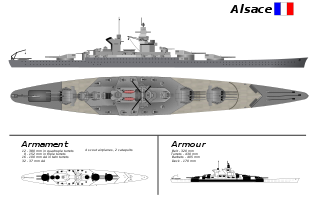
The Alsace class was a pair of fast battleships planned by the French Navy in the late 1930s in response to German plans to build two H-class battleships after the Second London Naval Treaty collapsed. The Alsace design was based on variants of the Richelieu class, and three proposals were submitted by the design staff. The proposed armament included nine or twelve 380 mm (15 in) guns or nine 406 mm (16 in) guns, but no choice was definitively made before the program ended in mid-1940. According to one pair of historians, logistical considerations—including the size of the 12-gun variant and the introduction of a new shell caliber for the 406 mm version—led the naval command to settle on the nine 380 mm design. But another pair of authors disagree, believing that the difficulty of designing and manufacturing a three-gun turret would have caused prohibitive delays during wartime, making the third, largest variant the most likely to have been built. The ships would have forced the French government to make significant improvements to its harbor and shipyard facilities, as the smaller Richelieus already stretched the limitations of existing shipyards. With construction of the first member of the class scheduled for 1941, the plan was terminated by the German victory in the Battle of France in May–June 1940.

The D-class cruisers were a pair of German heavy cruisers, classified as panzerschiffe by the Reichsmarine. The ships were improved versions of the preceding Deutschland-class cruisers, authorized by Adolf Hitler in 1933. They were intended to counter a new French naval construction program. Displacement increased to 20,000 long tons (20,000 t), but Hitler allowed only increases to armor, prohibiting additions to the ships' main battery armament. Both ships were laid down in February 1934, but not much work done before work was cancelled pending a significant revision of the design. It was determined that the ships should be enlarged to counter the new French Dunkerque-class battleship. The construction contracts for both ships were superseded by the Scharnhorst-class battleships.

The 16"/45 caliber Mark 6 gun is a naval gun designed in 1936 by the United States Navy for their Treaty battleships. It was introduced in 1941 aboard their North Carolina-class battleships, replacing the originally intended 14"/50 caliber Mark B guns and was also used for the follow-up South Dakota class. These battleships carried nine guns in three three-gun turrets. The gun was an improvement to the 16"/45 caliber guns used aboard the Colorado class, and the predecessor to the 16"/50 caliber Mark 7 gun used aboard the Iowa class.
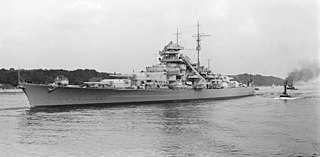
The Bismarck class was a pair of fast battleships built for Nazi Germany's Kriegsmarine shortly before the outbreak of World War II. The ships were the largest and most powerful warships built for the Kriegsmarine; displacing more than 41,000 metric tons normally, they were armed with a battery of eight 38 cm (15 in) guns and were capable of a top speed of 30 knots. Bismarck was laid down in July 1936 and completed in September 1940, while her sister Tirpitz's keel was laid in October 1936 and work finished in February 1941. The ships were ordered in response to the French Richelieu-class battleships. They were designed with the traditional role of engaging enemy battleships in home waters in mind, though the German naval command envisioned employing the ships as long-range commerce raiders against British shipping in the Atlantic Ocean. As such, their design represented the strategic confusion that dominated German naval construction in the 1930s.

The H class was a series of battleship designs for Nazi Germany's Kriegsmarine, which were intended to fulfill the requirements of Plan Z in the late 1930s and early 1940s. The first variation, "H-39", called for six ships to be built, essentially as enlarged Bismarck-class battleships with 40.6 cm (16 in) guns and diesel propulsion. The "H-41" design improved the "H-39" ship with still larger main guns, eight 42 cm (16.5 in) weapons, and reinforced deck armor. The Construction Office of the Oberkommando der Marine (OKM) concluded their work with the "H-41" design, and were not involved in subsequent plans. Two of them, "H-42" and "H-43", increased the main battery yet again, with 48 cm (18.9 in) pieces, and the enormous "H-44" design ultimately resulted with 50.8 cm (20 in) guns. The ships ranged in size from the "H-39", which was 277.8 m long on a displacement of 56,444 t, to the "H-44", at 345 m on a displacement of 131,000 t. Most of the designs had a proposed top speed in excess of 30 knots (56 km/h).







